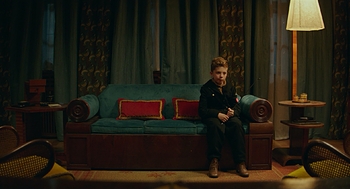

Explore the world of aspect ratios in cinematography. Learn about common ratios, their impact on storytelling, and how directors and cinematographers collaborate to choose the perfect frame. Gain insights into the technical and creative considerations behind this crucial filmmaking decision.

Ah, aspect ratios. The unsung heroes of cinematography that keep us awake at night and make producers scratch their heads in confusion. If you thought filmmaking was just about pointing a camera at stuff and yelling “action,” prepare to be underwhelmed by this exciting technical detail that somehow manages to be crucial to everything we do.

For those of you who haven’t spent countless hours debating the merits of 2.39:1 versus 2.35:1 (you lucky souls), aspect ratio is the relationship between the width and height of your image. It’s expressed as two numbers separated by a colon, like 16:9 or 2.39:1. The first number is width, the second is height. Riveting stuff, I know.
Why does it matter, you ask? Well, picture this: You’re shooting an epic space battle, and you’ve decided to go with a 4:3 aspect ratio. Suddenly, your majestic wide shots of starships look like they’re trying to squeeze into a phone booth. Not exactly the “Star Wars” vibe you were going for, eh?

Let’s dive into the exciting world of rectangles, shall we?

Picking an aspect ratio is like choosing an outfit for a blind date – you want to make a good impression, but you’re not quite sure what you’re getting into.
Ah, the beautiful dance of collaboration between directors and cinematographers. It’s like a tango, if the tango involved heated debates about rectangles and the occasional existential crisis about visual storytelling.

Picture this: You’re the cinematographer, armed with your light meter and a burning desire to create visual poetry. In walks the director, fresh from their morning coffee and ready to share their “vision.” And by vision, I mean they’ve decided that the entire film should be shot in 4:3 because it’s “retro.”
Now, as the cinematographer, you have two choices:
But here’s the kicker, folks. Sometimes, just sometimes, the director actually knows what they’re talking about when it comes to aspect ratios. I know, I was shocked too.
Take it from the legendary Roger Deakins (yes, I’m name-dropping. Sue me.). He once said, and I quote: “Some directors just like to shoot 2:35 and that is just a given. Personal choice. Nothing profound.”
Imagine that. All those sleepless nights agonizing over the perfect aspect ratio, and sometimes it boils down to “I just like how it looks.” It’s almost as if filmmaking is some kind of… art form.
So, the next time you’re locked in a heated debate about aspect ratios with your director, remember: It could be worse. They could be insisting on shooting the entire film in vertical video “for the TikTok generation.”
Now, let’s say you’re the cinematographer and you’ve got a brilliant idea for the perfect aspect ratio. How do you convince the director without resorting to interpretive dance or voodoo?
Remember, at the end of the day, filmmaking is a collaborative art. And by collaborative, I mean a series of compromises that leave everyone equally unsatisfied. Isn’t that what cinema is all about?
Q: Who decides which aspect ratio to pick? A: If you’re lucky, it’s a collaborative decision between the director, cinematographer, and producer. If you’re not, it’s whatever the client saw in the last Marvel movie.
Q: Can the aspect ratio be changed after filming? A: Technically, yes. But unless you enjoy a good nervous breakdown in post-production, it’s best to decide before you start shooting.
Q: Why would someone choose a non-standard aspect ratio? A: Because being understood by your audience is overrated, and nothing says “artistic vision” like making your film unwatchable on most devices.
Q: Is there an aspect ratio that works for everything? A: Yes, it’s called “compromise.” It’s when you shoot in one ratio, then crop it to fit every possible screen, thereby ensuring that no one sees your film exactly as you intended. Perfection!
Q: How do I know if I’ve chosen the right aspect ratio? A: When the director, producer, and every opinionated crew member finally stop arguing about it. So… never.
Aspect ratio might seem like a minor detail in the grand scheme of filmmaking, but don’t let its simplicity fool you. It’s just another tool in our cinematographic toolbox of anxiety and second-guessing. Choose wisely, and you’ll create a compelling visual narrative. Choose poorly, and… well, there’s always the option of a career in still photography.
Remember, the frame you choose is more than just a border – it’s the stage on which your story unfolds. No pressure or anything. Now go forth and agonize over rectangles like the true artist you are. And if all else fails, just remember: at least you’re not the one who has to explain to the editor why half the shot is letterboxed.
Happy framing, and may the aspect ratio gods be ever in your favor!
